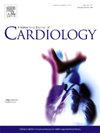成骨不全儿童的心脏表现:一项单中心观察性研究。
IF 3.2
2区 医学
Q2 CARDIAC & CARDIOVASCULAR SYSTEMS
引用次数: 0
摘要
背景:成骨不全症(Osteogenesis imperfecta, OI)是一种罕见的遗传性结缔组织疾病,以I型胶原合成缺陷为特征。在心血管系统中,I型胶原蛋白为心肌、心瓣膜、腱索和大血管提供抗拉强度和结构完整性。因此,成骨不全可能使受影响的个体易患各种心血管疾病。有限的现有文献表明成人成骨不全患者发生心力衰竭和瓣膜疾病的风险增加,但关于儿童成骨不全患者心脏受累的数据仍然有限。目的:本研究旨在探讨成骨不全儿童心脏结构和功能异常的患病率和特点。方法:78名患有成骨不全症的儿童(年龄1-18岁 ),儿科心脏病专家进行了标准化的心电图和超声心动图评估。使用儿童参考值计算z分数,并比较不同OI亚型之间的差异。结果:所有患者均无明显的心律失常或需要心血管药物治疗。13 %的患者发现先天性心脏缺陷,最常见的是ASD和PDA。轻度主动脉瓣或二尖瓣返流在7.3 %和8.7 %的患者中观察到,主动脉根扩张在8.7 %的患者中观察到,主要发生在中度至重度OI中。主动脉根部和主动脉环直径与疾病严重程度相关。所有患者左心室收缩功能和舒张功能均正常。结论:临床上相关的心血管疾病在成骨不全患儿中罕见,但在严重表型中二尖瓣和主动脉瓣反流和主动脉根部扩张更为普遍。中度至重度成骨不全患者转入成人护理前应考虑超声心动图筛查。本文章由计算机程序翻译,如有差异,请以英文原文为准。
Cardiac manifestations in children with osteogenesis imperfecta: A single-center observational study
Background
Osteogenesis imperfecta (OI) is a rare hereditary connective tissue disorder characterized by defective type I collagen synthesis. In the cardiovascular system, type I collagen provides tensile strength and structural integrity to the myocardium, cardiac valves, chordae tendineae and great vessels. OI may therefore predispose affected individuals to various cardiovascular diseases. Limited existing literature suggests an increased risk of developing heart failure and valvular diseases in adults with OI, but data on cardiac involvement in pediatric OI remains limited.
Objectives
This study aimed to investigate the prevalence and characteristics of structural and functional cardiac abnormalities in children with OI.
Methods
In 78 children (aged 1–18 years) with OI, pediatric cardiologists performed standardized ECG and echocardiographic evaluations. Z-scores were calculated using pediatric reference values and compared between OI subtypes.
Results
None of our patients had clinically significant arrhythmias or required cardiovascular medication. Congenital heart defects were identified in 13 % of patients, most commonly ASD and PDA. Mild aortic or mitral valve regurgitation were observed in 7.3 % and 8.7 % of patients and aortic root dilation in 8.7 %, predominantly in moderate to severe OI. Aortic root and annulus diameters correlated with disease severity. Left ventricular systolic function and diastolic function were normal in all patients.
Conclusions
Clinically relevant cardiovascular disease is rare in children with OI, but mitral and aortic valve regurgitations and aortic root dilation are more prevalent in severe phenotypes. Echocardiographic screening should be considered before transition to adult care in patients with moderate to severe OI.
求助全文
通过发布文献求助,成功后即可免费获取论文全文。
去求助
来源期刊

International journal of cardiology
医学-心血管系统
CiteScore
6.80
自引率
5.70%
发文量
758
审稿时长
44 days
期刊介绍:
The International Journal of Cardiology is devoted to cardiology in the broadest sense. Both basic research and clinical papers can be submitted. The journal serves the interest of both practicing clinicians and researchers.
In addition to original papers, we are launching a range of new manuscript types, including Consensus and Position Papers, Systematic Reviews, Meta-analyses, and Short communications. Case reports are no longer acceptable. Controversial techniques, issues on health policy and social medicine are discussed and serve as useful tools for encouraging debate.
 求助内容:
求助内容: 应助结果提醒方式:
应助结果提醒方式:


